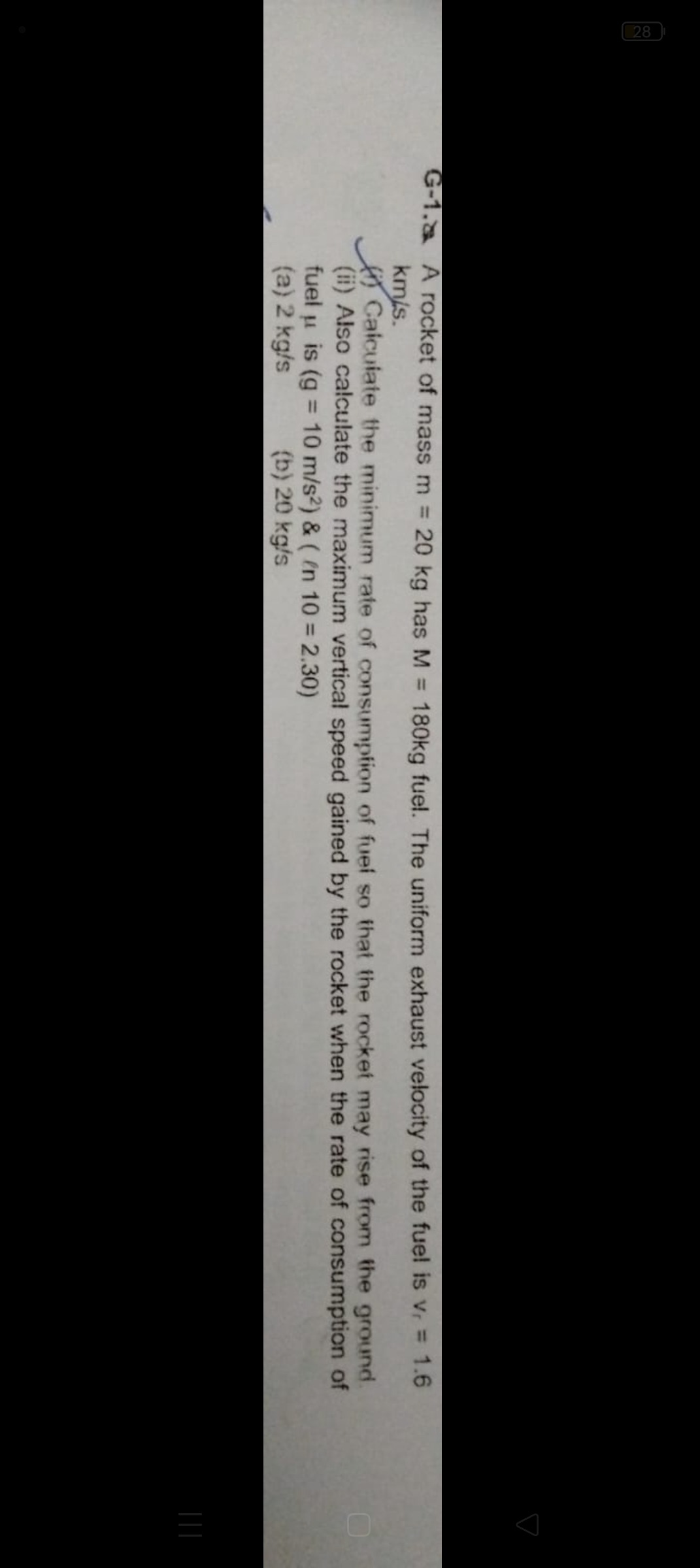Question
Question: A rocket of mass m = 20 kg has M = 180kg fuel. The uniform exhaust velocity of the fuel is $v_r$ = 1...
A rocket of mass m = 20 kg has M = 180kg fuel. The uniform exhaust velocity of the fuel is vr = 1.6 km/s. (i) Calculate the minimum rate of consumption of fuel so that the rocket may rise from the ground. (ii) Also calculate the maximum vertical speed gained by the rocket when the rate of consumption of fuel μ is (g = 10 m/s²) & (ln 10 = 2.30)

The minimum rate of consumption of fuel is 1.25 kg/s. The maximum vertical speed gained is 2780 m/s for μ = 2 kg/s and 3590 m/s for μ = 20 kg/s.
Solution
Part (i): Minimum rate of consumption of fuel so that the rocket may rise from the ground.
For the rocket to lift off from the ground, the upward thrust force must be at least equal to the initial weight of the rocket. The thrust force (Ft) is given by the product of the rate of fuel consumption (μ=−dtdm) and the exhaust velocity relative to the rocket (vr). Ft=μvr
The initial total mass of the rocket is M0=mrocket+mfuel=20 kg+180 kg=200 kg. The initial gravitational force is Fg=M0g.
For lift-off, Ft≥Fg. The minimum rate of fuel consumption (μmin) occurs when Ft=Fg. μminvr=M0g μmin=vrM0g
Given: M0=200 kg, g=10 m/s2, vr=1.6 km/s=1600 m/s. μmin=1600 m/s200 kg×10 m/s2=16002000 kg/s=1620 kg/s=45 kg/s=1.25 kg/s.
The minimum rate of consumption of fuel is 1.25 kg/s.
Part (ii): Maximum vertical speed gained by the rocket when the rate of consumption of fuel μ is given.
The equation of motion for a rocket moving vertically upwards under gravity is: mdtdv=Ft−mg mdtdv=μvr−mg where m(t) is the instantaneous mass, v(t) is the instantaneous velocity, μ=−dtdm is the constant rate of fuel consumption, and vr is the exhaust velocity. Rearranging and integrating from t=0 (velocity v=0, mass M0) to time T when fuel is exhausted (velocity vf, mass mrocket): dv=(mμvr−g)dt Since μ=−dtdm is constant, dt=−μdm. Also, m(t)=M0−μt, so t=μM0−m. The burn time is T=μM0−mrocket.
Integrating the equation of motion: ∫0vfdv=∫0TM0−μtμvrdt−∫0Tgdt vf=μvr∫0TM0−μtdt−g∫0Tdt For the first integral, let u=M0−μt, du=−μdt. When t=0, u=M0. When t=T, u=M0−μT=mrocket. ∫0TM0−μtdt=∫M0mrocketu−du/μ=−μ1[ln∣u∣]M0mrocket=−μ1(lnmrocket−lnM0)=μ1ln(mrocketM0). The second integral is ∫0Tgdt=gT.
So, vf=μvr(μ1ln(mrocketM0))−gT=vrln(mrocketM0)−gT. The burn time T=μmfuel=μM0−mrocket. vf=vrln(mrocketM0)−gμM0−mrocket.
Given: mrocket=20 kg, M0=200 kg, vr=1600 m/s, g=10 m/s2, ln10=2.30. mrocketM0=20200=10. vrln(mrocketM0)=1600ln(10)=1600×2.30=3680 m/s. M0−mrocket=200−20=180 kg.
The formula for the maximum vertical speed (at the end of the burn) is vf=3680−10×μ180.
(a) μ=2 kg/s vf=3680−10×2180=3680−10×90=3680−900=2780 m/s.
(b) μ=20 kg/s vf=3680−10×20180=3680−10×9=3680−90=3590 m/s.
The maximum vertical speed gained is 2780 m/s for μ=2 kg/s and 3590 m/s for μ=20 kg/s.
